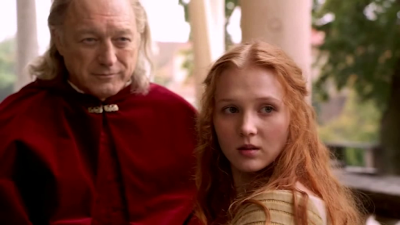Due to a bit of writers block I thought I would share a post I did a while ago, all about my trip to the Borgia apartments at the Vatican.
The Disputation of St Catherine - Pinturicchio
After Rodrigo Borgia became Pope in 1492, he planned a whole new set of rooms for his personal use. These rooms still exist today, and in them survive a fascinating insight into the Borgia mindset. The walls are covered in frescoes of the Borgia bull, and the entire set of apartments show the Spanish roots of the new Pope - the floor tiles were imported especially from Spain, giving the rooms a completely Spanish look, and mixed in with the frescoes of the Borgia bull are are representations of the Aragonese double crown, to which they added sun rays or flames mixed in a grazing bull.
The Borgia Bull, Borgia Apartments (picture by me)
The Borgia Bull and the Aragonese Crown, Borgia Apartments (picture by me)
Spanish Tiles, Borgia Apartments (picture by me)
Borgia Coat of Arms, Borgia Apartments (picture by me)
As can be seen from the pictures above, Pope Alexander made sure the family device was everywhere - gilded Borgia bulls on the ceiling in a repeated pattern with the Aragonese arms, Spanish tiles all over the floors as well as gilded stucco frames around the frescoes. The entire space was created to reflect the pride Alexander felt in his family name, pride at their Spanish origins and the huge ambition that he had for himself and his family.
Quite possibly, the most impressive monument to the Borgia family surviving in those set of rooms hidden away in the Vatican (and used to house a contemporary art gallery, I wasn't too impressed with that!) are the frescoes that surround the walls of the main room.
The Disputation of St Catherine, Pinturicchio (Picture by me)
After his election to the Chair of St Peter in 1492, Pope Alexander hired Bernadino di Betto di Biagio (better known as Pinturicchio) to paint his new apartments. Pinturicchio was an incredibly talented artist from Sienna, and one of the most sought after artists in his day and had even assisted in the painting of the Sistine Chapel. And whilst some weren't all that impressed with his works, the Pope certainly was.
The most famous fresco is the one shown above: The Disputation of St Catherine. And it is the biggest testament to the Borgia family in the room, simply because it contains images of the Borgia family. Most are dressed in the Turkish fashion whilst St Catherine (Said to be an image of Lucrezia, and I have to say I agree wholeheartedly) argues against the Pagan emperor.
The entire image is full of imagery - in the centre stands a triumphal arch based on the Arch of Constantine and sat atop it is the Borgia bull. The arch of Constantine is an incredible monument to Christianity - the arch itself (still standing outside the Colosseum) was built as a celebration of Constantine's victory at the Battle of the Milvian Bridge which established Christianity as the official religion of the Roman Empire. In essence, it's place in the painting is saying that the Borgia family are as important to Christianity as Constantine was - reinforced by the Borgia bull sat right on top of said arch. And not only are members of Alexander's family depicted (Lucrezia, Cesare, Juan, Joffre and Sancia) but also other members of the papal entourage and it is said, though I haven't yet found a source for this and will update as and when I do, that the man sat in the chair is actually a self portrait of Pinturicchio himself.
As for the imagery of the family, the main figure in the painting is St Catherine. She is portrayed as blonde, the known hair colour of Lucrezia Borgia, and this image has long been traditionally held as an image of Lucrezia although there is, of course, no certainty of this.
Detail of St Catherine showing the supposed figures of Lucrezia and Cesare (Picture by me)
The figure behind her, dressed in Turkish robes and glaring out, is said to be an image of Cesare Borgia while the figure on the left hand side (the right as we look at it) is traditionally held to be an image of Juan Borgia, second Duke of Gandia.
Detail of the figure said to be Juan Borgia in The Disputation of St Catherine
The two diminutive figures at the front of the painting are said to be of Joffre Borgia and his wife, Sancia of Aragon.
Figures said to be of Jofre Borgia and Sancia of Aragon from The Disputation of St Catherine
Pope Alexander himself is not shown in the Disputation of St Catherine. He is however shown in the fresco "Resurrection", in which he witnesses the Resurrection of Christ during a moment of prayer. He has his hands clasped in prayer, dressed in embroidered robes and his papal tiara on the floor before him. Pinturicchio also painted another portrait of Alexander above a doorway adoring a beautiful virgin who, according to Vasari was given the face of Giulia Farnese. This portrait however was destroyed when the room it was in, was destroyed for other building works.
The Resurrection by Pinturicchio
Detail of Pope Alexander VI, Pinturicchio
In all then, the Borgia apartments are a testament to the sheer self belief of the Borgia family, their belief in unbridled power and the pride that Alexander felt in his family origins.
And one last picture from my visit last year, though this could have been carved at an point throughout the room's history - a gaming board carved into a windowsill which I found to be incredibly interesting. I have no idea how the game was played but it certainly looks interesting!
Random gaming board in the Borgia Apartments (Picture by me)
Further reading










.jpg)

